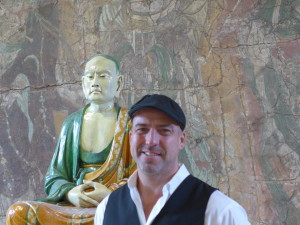The Buddhist Cave Art of Dunhuang
Tibet is considered the Buddhist capital of China, causing many not familiar with China’s geography to believe that Buddhism came to China from India through Tibet. But with the highest mountain peaks in the world, the Himalayas, separating India and China, Buddhism had to take a different route. Instead, it first entered China through what has become known as the Silk Road. As a result, some very early Buddhist art can be found in remote northwestern regions of China. One such example are the Buddhist cave art in Dunhuang, an oasis town situated in the Gobi Desert. The Mogao Caves are probably the best known.
But any trip to the Mogao caves by a Buddhist art novice leaves one with many questions on the art, the history and its significance. But in April 2015, after a trip to Dunhuang, China Law & Policy had the opportunity to sit down with Dr. Neil Schmid, an American expert on Buddhist Studies and Dunhuang to discuss the art, the cosmopolitan nature of ancient Dunhuang and where some of those multicultural artifacts are now located.
Listen to the Interview with Neil Schmid:
Length: 21:47 minutes
Click here to open a PDF of the Transcript of the Neil Schmid Interview.
If the length of the interview is too long for one sitting, check out our “two-part breakdown” of the 21 minute interview:
Part 1 – The Buddhist Art of Dunhuang – 10:00 minutes
Part 2 – Dunhuang Caves – Who Owns This Art? – 12:29 minutes
 On Facebook
On Facebook By Email
By Email 
